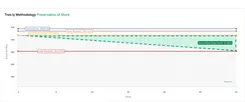As you probably know by now, Tree.ly is a climate tech startup which helps forest owners get compensated for the ecosystem services they provide. But how do we go about this? Here we take the chance to explain what kind of forests are benefiting, how they are categorised and – most importantly – how we arrive at our carbon sequestration potential with which forest owners are compensated.
First things first: Initial analysis
At present, we’re working with those who own upwards of 500 ha and maintain a forest inventory and management protocols. The first step is for current forest inventory to be determined, so our tech team can work out projected carbon estimations. The optimal stock range is then modeled, based on techniques established by BOKU and ETH Zürich. This analysis considers factors such as tree species, vegetation altitude, growth potential, and more. Based on these values, upper and lower boundaries are established, which are key for setting the framework and benchmarks for projects.
Once each project has been assessed, it is assigned into one of two categories: Carbon Removal or Carbon Conservation as defined by the IPCC. Let’s look deeper at these two.
Project Type: Carbon Removal (increase of stock)
This is the ‘classic’ afforestation model, which mostly concerns adding to existing tree stock through measures such as forest management and planting activities.

The key here is maintaining (and growing) the current stock, using sustainable forestry management to care for and reach the chosen stock commitment. This number is chosen by the owner and agreed with Tree.ly as a realistic goal for the lifetime of the project; the duration can be set between 1 – 30 years.
In the above example, the commitment is to increase the stock by 50 m³ / ha in 30 years. In a project area of 1000 ha this would mean 50 m³/ha over the project lifetime – equal to an estimated 2100 tonnes of CO₂ per year.
Project Type: Carbon Conservation (preservation of stock)
For this project type, we lend kudos to the slightly ‘unsexier’ side of forestry – rather than headline-grabbing tree planting ventures, this is all about maintaining existing stocks so that they continue to capture carbon for another generation or more.
Crucially, older trees are jam-packed with biodiversity and provide habitats to a huge array of wildlife. “Forests create an enabling environment for life to flourish,” writes Cambridge sustainability expert Wayne Visser. “This is why planting trees is not enough we need to protect and expand forest ecosystems.”
Even with strong forestry laws we have in Central Europe, it is an achievement to keep up a certain amount of stock - an ecosystem service which should be recognised. Thanks to Tree.ly, forest owners finally have a way of monetising the ecosystem value of their forests. They are thereby rewarded for guaranteeing a certain stockage – instead of cutting down for wood, for example, they are incentivised to commit to a certain stock in the forest.
Here the lower and upper boundaries are key. Let’s say a total project area is 1454 ha, with a current stock of 390 m³/ha. The forest owner commits to not go under 370 m³/ha and maintain this for 30 years – the default project length. In carbon terms, this commitment is equal to 89 tCO₂/ha, adding up to 129 406 tCO₂ over 30 years (contact us to find out the financial and earning implications).

Project Type: Removal & Conservation (combined project)
As well as the main two types, forest owners also have the option to combine the above two.
What happens next?
An annual report is carried out, on the basis of which the forest owner is paid. The report includes information on activities as well as any calamities which may have occurred. The certification body then issues carbon credits based on this report, which Tree.ly then sells on the voluntary carbon market.
Contact our forestry expert Alexander Vilsmeier to find out more about our project types, and how to get involved.
Typical project timeline:















